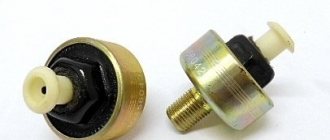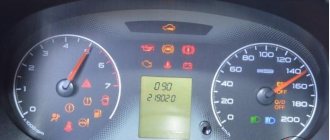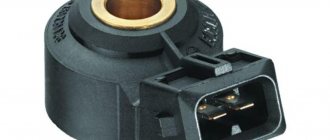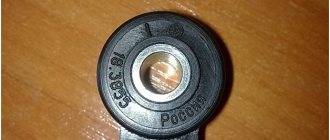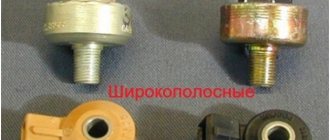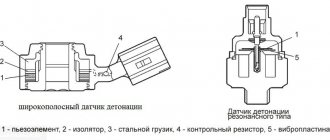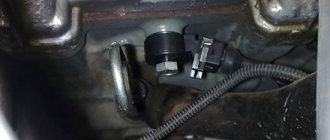A knock detection sensor (DS) in the engine cylinders was not an obvious need in the first engine control systems, and in the days of simpler principles of power management and ignition of gasoline internal combustion engines, abnormal combustion of the mixture was not monitored at all. But then the engines became more complex, the requirements for efficiency and exhaust purity increased sharply, which required an increase in the amount of control over their operation at each time.
Lean and ultra-lean mixtures, exorbitant compression ratios and other similar factors require constant work on the verge of detonation without going beyond this threshold.
Where is the knock sensor located and what does it affect?
Typically, the DD is installed on a threaded mount to the cylinder block, near the central cylinder closer to the combustion chambers. Its location is determined by the tasks it is called upon to perform.
Roughly speaking, a knock sensor is a microphone that picks up very specific sounds produced by a detonation wave hitting the walls of the combustion chambers.
This wave itself becomes the result of anomalous combustion in the cylinders at a very high speed. The difference between the standard process and the detonation process is the same as during the operation of a propelling powder charge in an artillery gun and a high explosive with which a projectile or grenade is filled.
The gunpowder burns slowly and pushes, and the contents of the landmine crush and destroy. The difference in the speed of propagation of the combustion boundary. During detonation it is many times higher.
In order not to damage engine parts, the occurrence of detonation must be noticed and stopped in time. Once upon a time, it was possible to afford the cost of excessive fuel consumption and environmental pollution in order to avoid detonation of the mixture in principle.
Gradually, motor technology reached such a level that all reserves were exhausted. It was necessary to force the engine to independently extinguish the resulting detonation. And an acoustic control “ear” was attached to the engine, which became the knock sensor.
Vehicle behavior
If the knock sensor fails, the behavior of the vehicle changes. The following symptoms may indicate a faulty motor:
- fuel consumption has increased while maintaining the same operating conditions and external factors;
- deterioration of vehicle dynamics;
- a check light lights up on the dashboard;
- detonation sounds often occur;
- increased smokiness of exhaust gases is visually noticeable;
- the power of the power unit has decreased;
- The engine overheats periodically.
Types of sensors
According to the spectral characteristics, historically there are two of them - resonant and broadband .
In the first, a pronounced reaction to very specific sound frequencies is used to increase sensitivity. It is known in advance what spectrum is produced by the parts suffering from the shock wave; it is for them that the sensor is structurally adjusted.
Related article: Replacing the front strut support bearing with and without removing the shock absorber
A broadband type sensor has less sensitivity, but it detects vibrations of different frequencies. This allows you to unify the devices and not have to select their characteristics for a specific engine, and the greater ability to pick up weak signals is not in great demand; detonation has sufficient acoustic volume.
A comparison of both types of sensors led to the complete displacement of resonant DDs. Currently, only two-contact broadband toroidal sensors are used, secured to the block with a central pin and nut.
Varieties and compatibility
It would seem that the design of all knock sensors looks the same, and therefore they should all be compatible. However, in reality everything will be more complicated. The number of pins on the sensor is always two. But the shape of the connector may differ. And most importantly, even the internal electrical resistance is different:
- Sensors designed for VAZ engines have almost infinite resistance (cannot be measured);
- Typical DD resistance for Subaru and Nissan is 500 - 560 kOhm;
- Hyundai DD resistance is 5 megaohms.
Sensor modules may also differ in shape:
Three different DD sensors
If we talk about Chinese cars, you can find out this:
- For all Lifan engines, the DD with the number LF479Q1-3612200A or LF479Q3-3612200B is suitable;
- The part with the designation LBA3612400B1 is an original Lifan DD;
- DD “0261231176” (engine ZMZ-405/409 EURO-3) will be fully compatible with the Lifan sensor;
- Electrically, but not by connector, the sensor from ZMZ-406 (EURO-3) is compatible with Lifan.
Symptoms of a problem
During normal engine operation, the knock sensor does not produce danger signals and does not participate in the operation of the control system in any way. The ECU program performs all actions according to its data cards hardwired into memory; standard modes ensure knock-free combustion of the air-fuel mixture.
But with significant temperature deviations in the combustion chambers, detonation may occur. The task of the DD is to give a signal in time to parry the danger. If this does not happen, then characteristic sounds are heard from under the hood, which for some reason drivers call finger tapping.
Although in fact no fingers are knocking, and the main level of volume comes from the vibration of the piston bottom, which is hit by a wave of explosive combustion. This is the main sign of abnormal operation of the knock control subsystem.
Indirect signs will be a noticeable loss of engine power, an increase in its temperature, up to the appearance of glow ignition, and the inability of the ECU to cope with the situation in normal mode. The reaction of the control program in such cases will be to light up the “Check Engine” light.
Typically, the ECU directly monitors the activity of the knock sensor. Its signal levels are known and stored in memory. The system compares the current information with the tolerance range and, when deviations are detected, simultaneously with the display turning on, it remembers error codes.
This is interesting: Checking diesel engine injectors and ways to clean them at home
These are various types of exceeding or decreasing the levels of the DD signal, as well as a complete break in its circuit. Error codes can be read from the on-board computer or an external scanner via the diagnostic connector.
Error codes can be read from the on-board computer or an external scanner via the diagnostic connector.
If you don’t have a diagnostic device, we recommend paying attention to the budget multi-brand auto scanner Scan Tool Pro Black Edition
.
A special feature of this Korean-made model is the diagnostics of not only the engine, as in most budget Chinese models, but also other components and assemblies of the car (gearbox, ABS auxiliary systems, transmission, ESP, etc.).
Also, this device is compatible with most cars starting from 1993, works stably without loss of communication with all popular diagnostic programs and has a fairly affordable price.
How to check the knock sensor
Knowing the design and principle of operation of the motor, you can check it in fairly simple ways, both by removing it from the engine and locally, including directly with the engine running.
Voltage measurement
A multimeter is connected to the sensor removed from the cylinder block in voltage measurement mode. By carefully bending the DD body through a screwdriver inserted into the hole in the sleeve, you can monitor the reaction of the built-in piezoelectric crystal to the deforming force.
Note: How to cover a steering wheel with braid: types and methods of lacing
The appearance of voltage at the connector and its value of the order of two to three tens of millivolts approximately indicates the serviceability of the device’s piezoelectric generator and its ability to generate a signal in response to mechanical stress.
Resistance measurement
Some sensors contain a built-in resistor connected as a shunt. Its value is on the order of tens or hundreds of kOhms. An open or short circuit in the circuit inside the case can be detected by connecting the same multimeter in resistance measurement mode.
The device must show the value of the shunt resistor, since the piezoelectric crystal itself has an almost infinitely large resistance that cannot be measured with a conventional multimeter. In this case, the readings of the device will also depend on the mechanical impact on the crystal due to the generation of voltage that distorts the ohmmeter readings.
Checking the sensor on the ECU connector
Having determined the required contact of the ECU controller connector from the electrical diagram of the car, the condition of the sensor can be checked more completely, with the inclusion of the supply wiring circuits.
The same measurements as described above are carried out on the removed connector; the only difference will be a simultaneous check of the cable’s serviceability. By bending and tugging the wires, they make sure that there is no stray fault, when contact appears and disappears due to mechanical vibrations. Corroding places where wires are inserted into connector tips are especially affected by this.
On topic: Checking gasoline injectors from A to Z
With the ECU connected and the ignition on, you can check the presence of a reference voltage at the sensor and the correctness of its division by external and built-in resistors, if this is provided for by the circuit of a particular vehicle.
Typically, the +5 Volt support is divided approximately in half and an alternating signal is generated against the background of this constant component.
Checking with an oscilloscope
The most accurate and complete instrument method will require the use of an automotive digital storage oscilloscope or an oscilloscope attachment to a diagnostic computer.
When hitting the DD body, the screen will show how capable the piezoelement is of generating steep fronts of the detonation signal, whether the seismic mass of the sensor works correctly, preventing extraneous damped oscillations, and whether the amplitude of the output signal is sufficient.
The technique requires sufficient experience in diagnostics and knowledge of typical signal pictures of a working device.
Checking on a running engine
The simplest test method does not even require the use of electrical measuring instruments. The engine starts and reaches below average speed. When applying moderate blows to the knock sensor, you can observe the reaction of the ECU to the appearance of its signals.
There should be a normal rebound of the ignition timing and an associated drop in the steady-state engine speed. The method requires a certain skill, since not all motors react equally to such testing.
Voltage measurement at idle
The performance of the motor can be determined by measuring the voltage at its contacts with the engine running at idle speed. The table below shows approximate voltage values that can be used to identify a malfunction of the knock sensor.
Table - Approximate voltage values
| Voltage, V | Sensor status |
| 0-0.01 | Unusable, voltage too low |
| 0.2-4.5 | Knock meter is OK |
| Over 5 | Sensor broken, voltage too high |
Replacing the knock sensor
DD refers to attachments, the replacement of which does not present any difficulties. The body of the device is conveniently secured to a stud and to remove it, just unscrew one nut and remove the electrical connector.
Sometimes, instead of a stud, a bolt is used on a thread in the body of the block. Difficulties can only arise if the threaded connection is corroded, since the device is very reliable and its removal is required extremely rarely.
An all-purpose penetrating lubricant, sometimes called liquid wrench, will help.
